A blog about Marinwood-Lucas Valley and the Marin Housing Element, politics, economics and social policy. The MOST DANGEROUS BLOG in Marinwood-Lucas Valley.
Saturday, November 19, 2016
Friday, November 18, 2016
Marin Students Walkout of Class to Protest.
Video of the San Rafael High School protest
Marin students protest Trump victory with walkouts
By Janis Mara, Marin Independent Journal
POSTED: |
273 COMMENTS
Students from high schools throughout Marin and the College of Marin walked out of classes Monday to stage peaceful protests in the wake of the presidential election.
Students from Redwood, Tamalpais, Sir Francis Drake, Terra Linda, San Marin and Novato high schools participated in the walkout Monday. Marin Academy students demonstrated last week.
High school students left class by the hundreds Monday in several U.S. cities, walking out in California, Maryland and Oregon. Many expressed concern over President-elect Trump’s comments about minorities and the effect he will have on their communities.
“I feel really happy students are finding their voice. It’s important for all students to express themselves,” said Amy Martinez, who teaches English language development for newcomers at Terra Linda.
“A lot of them are frightened as to what this means for them and their families,” Martinez said. Terra Linda High School had 450 Hispanic/Latino students in the 2015-16 school year and 505 white students, according to data from the state Department of Education.
Demonstrator Ana Smiler Ostrovsky, one of the organizers of the Terra Linda protest, described the walkout as targeting “any government action that goes against pro-choice, limits who we can marry, deports any of our loved community.” See article HERE
Officials scramble to overhaul San Rafael Transit Center to accommodate SMART trains
 |
| Illustration by Seamus O'Reamus |
By Mark Prado, Marin Independent Journal
POSTED: |
11 COMMENTS
The transit center in downtown San Rafael will have to be revamped quickly so SMART trains can pass through the hub en route to Larkspur as soon as 2018.
The big changes will come as Golden Gate Bridge district officials make plans to move the entire center in as soon as five years.
It was the district that gave Sonoma-Marin Area Rail Transit a right of way through the center, so the disruption is not a complete surprise.
Officials at the district, which runs buses in and out of the transit center, initially planned to study the center’s future and where it might be located as SMART came online.
But last December SMART officials announced the agency was in line to receive funding to extend the commuter rail service to Larkspur, which includes going through the transit center. With construction of commuter train service to Larkspur starting as soon as summer 2017, the transit center will have to be revamped to squeeze rail and bus service into the site. See the Full Story in the Marin IJ HERE
Thursday, November 17, 2016
Wednesday, November 16, 2016
How Half Of America Lost Its F**king Mind
How Half Of America Lost Its F**king Mind
By
October 12, 2016
I'm going to explain the Donald Trump phenomenon in three movies. And then some text.
There's this universal shorthand that epic adventure movies use to tell the good guys from the bad. The good guys are simple folk from the countryside ...

Lionsgate Films
... while the bad guys are decadent assholes who live in the city and wear stupid clothes:
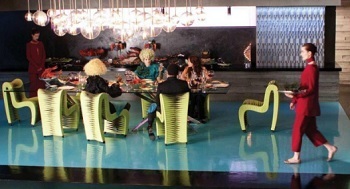
... while the bad guys are decadent assholes who live in the city and wear stupid clothes:

Lionsgate Films
In Star Wars, Luke is a farm boy ...

In Star Wars, Luke is a farm boy ...

LucasFilm
... while the bad guys live in a shiny space station:

... while the bad guys live in a shiny space station:

LucasFilm
In Braveheart, the main character (Dennis Braveheart) is a simple farmer ...
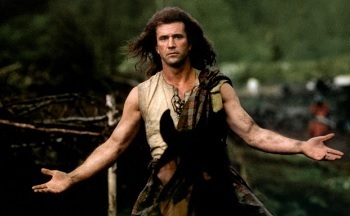
In Braveheart, the main character (Dennis Braveheart) is a simple farmer ...

Paramount Pictures
... and the dastardly Prince Shithead lives in a luxurious castle and wears fancy, foppish clothes:

... and the dastardly Prince Shithead lives in a luxurious castle and wears fancy, foppish clothes:

Paramount Pictures
The theme expresses itself in several ways -- primitive vs. advanced, tough vs. delicate, masculine vs. feminine, poor vs. rich, pure vs. decadent, traditional vs. weird. All of it is code for rural vs. urban. That tense divide between the two doesn't exist because of these movies, obviously. These movies used it as shorthand because the divide already existed.
We country folk are programmed to hate the prissy elites. That brings us to Trump.
6It's Not About Red And Blue States -- It's About The Country Vs. The City

The theme expresses itself in several ways -- primitive vs. advanced, tough vs. delicate, masculine vs. feminine, poor vs. rich, pure vs. decadent, traditional vs. weird. All of it is code for rural vs. urban. That tense divide between the two doesn't exist because of these movies, obviously. These movies used it as shorthand because the divide already existed.
We country folk are programmed to hate the prissy elites. That brings us to Trump.
6It's Not About Red And Blue States -- It's About The Country Vs. The City

Mark Makela/Getty Images
I was born and raised in Trump country. My family are Trump people. If I hadn't moved away and gotten this ridiculous job, I'd be voting for him. I know I would.
See, political types talk about "red states" and "blue states" (where red = Republican/conservative and blue = Democrat/progressive), but forget about states. If you want to understand the Trump phenomenon, dig up the much more detailed county map. Here's how the nation voted county by county in the 2012 election -- again, red is Republican:
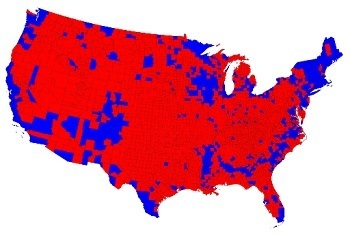
I was born and raised in Trump country. My family are Trump people. If I hadn't moved away and gotten this ridiculous job, I'd be voting for him. I know I would.
See, political types talk about "red states" and "blue states" (where red = Republican/conservative and blue = Democrat/progressive), but forget about states. If you want to understand the Trump phenomenon, dig up the much more detailed county map. Here's how the nation voted county by county in the 2012 election -- again, red is Republican:

Mark Newman / University of MichiganThe country is lava.
Holy cockslaps, that makes it look like Obama's blue party is some kind of fringe political faction that struggles to get 20 percent of the vote. The blue parts, however, are more densely populated -- they're the cities. In the upper left, you see the blue Seattle/Tacoma area, lower down is San Francisco and then L.A. The blue around the dick-shaped Lake Michigan is made of cities like Minneapolis, Milwaukee, and Chicago. In the northeast is, of course, New York and Boston, leading down into Philadelphia, which leads into a blue band which connects a bunch of southern cities like Charlotte and Atlanta.
Blue islands in an ocean of red. The cities are less than 4 percent of the land mass, but 62 percent of the population and easily 99 percent of the popular culture. Our movies, shows, songs, and news all radiate out from those blue islands.
And if you live in the red, that fucking sucks.
See, I'm from a "blue" state -- Illinois -- but the state isn't blue. Freaking Chicago is blue. I'm from a tiny town in one of the blood-red areas:
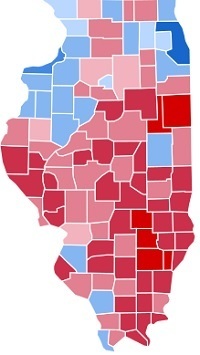
Holy cockslaps, that makes it look like Obama's blue party is some kind of fringe political faction that struggles to get 20 percent of the vote. The blue parts, however, are more densely populated -- they're the cities. In the upper left, you see the blue Seattle/Tacoma area, lower down is San Francisco and then L.A. The blue around the dick-shaped Lake Michigan is made of cities like Minneapolis, Milwaukee, and Chicago. In the northeast is, of course, New York and Boston, leading down into Philadelphia, which leads into a blue band which connects a bunch of southern cities like Charlotte and Atlanta.
Blue islands in an ocean of red. The cities are less than 4 percent of the land mass, but 62 percent of the population and easily 99 percent of the popular culture. Our movies, shows, songs, and news all radiate out from those blue islands.
And if you live in the red, that fucking sucks.
See, I'm from a "blue" state -- Illinois -- but the state isn't blue. Freaking Chicago is blue. I'm from a tiny town in one of the blood-red areas:

Inqvisitor / Wiki CommonsWhere Oprahs fear to tread.
As a kid, visiting Chicago was like, well, Katniss visiting the capital. Or like Zoey visiting the city of the future in this ridiculous book. "Their ways are strange."
And the whole goddamned world revolves around them.
Every TV show is about LA or New York, maybe with some Chicago or Baltimore thrown in. When they did make a show about us, we were jokes -- either wide-eyed, naive fluffballs (Parks And Recreation, and before that, Newhart) or filthy murderous mutants (True Detective, and before that, Deliverance). You could feel the arrogance from hundreds of miles away.

As a kid, visiting Chicago was like, well, Katniss visiting the capital. Or like Zoey visiting the city of the future in this ridiculous book. "Their ways are strange."
And the whole goddamned world revolves around them.
Every TV show is about LA or New York, maybe with some Chicago or Baltimore thrown in. When they did make a show about us, we were jokes -- either wide-eyed, naive fluffballs (Parks And Recreation, and before that, Newhart) or filthy murderous mutants (True Detective, and before that, Deliverance). You could feel the arrogance from hundreds of miles away.

Warner Brothers Pictures
You're not allowed to visit a dentist if you live more than 10 miles from the highway, apparently.
"Nothing that happens outside the city matters!" they say at their cocktail parties, blissfully unaware of where their food is grown. Hey, remember when Hurricane Katrina hit New Orleans? Kind of weird that a big hurricane hundreds of miles across managed to snipe one specific city and avoid everything else. To watch the news (or the multiple movies and TV shows about it), you'd barely hear about how the storm utterly steamrolled rural Mississippi, killing 238 people and doing an astounding $125 billion in damage.
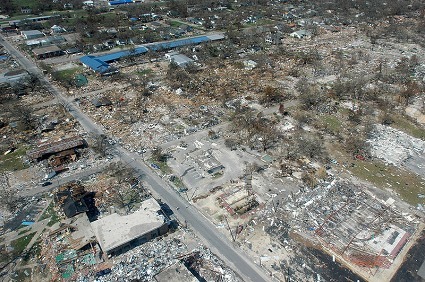
"Nothing that happens outside the city matters!" they say at their cocktail parties, blissfully unaware of where their food is grown. Hey, remember when Hurricane Katrina hit New Orleans? Kind of weird that a big hurricane hundreds of miles across managed to snipe one specific city and avoid everything else. To watch the news (or the multiple movies and TV shows about it), you'd barely hear about how the storm utterly steamrolled rural Mississippi, killing 238 people and doing an astounding $125 billion in damage.

Mark Wolfe / FEMANo sports team = no fucks given.
But who cares about those people, right? What's newsworthy about a bunch of toothless hillbillies crying over a flattened trailer? New Orleans is culturally important. It matters.
To those ignored, suffering people, Donald Trump is a brick chucked through the window of the elites. "Are you assholes listening now?"
5City People Are From A Different Goddamned Planet
 Justin Sullivan/Getty Images
Justin Sullivan/Getty Images
"But isn't this really about race? Aren't Trump supporters just a bunch of racists? Don't they hate cities because that's where the brown people live?"
Look, we're going to get actual Nazis in the comment section of this article. Not "calling them Nazis for argument points" Nazis, but actual "Swastikas in their avatars, rooted against Indiana Jones" Nazis. Those people exist.
But what I can say, from personal experience, is that the racism of my youth was always one step removed. I never saw a family member, friend, or classmate be mean to the actual black people we had in town. We worked with them, played video games with them, waved to them when they passed. What I did hear was several million comments about how if you ever ventured into the city, winding up in the "wrong neighborhood" meant you'd get dragged from your car, raped, and burned alive. Looking back, I think the idea was that the local minorities were fine ... as long as they acted exactly like us.
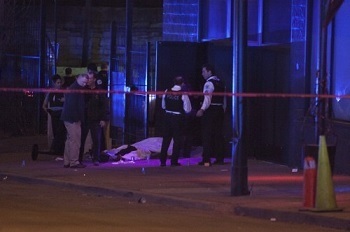
But who cares about those people, right? What's newsworthy about a bunch of toothless hillbillies crying over a flattened trailer? New Orleans is culturally important. It matters.
To those ignored, suffering people, Donald Trump is a brick chucked through the window of the elites. "Are you assholes listening now?"
5City People Are From A Different Goddamned Planet
 Justin Sullivan/Getty Images
Justin Sullivan/Getty Images"But isn't this really about race? Aren't Trump supporters just a bunch of racists? Don't they hate cities because that's where the brown people live?"
Look, we're going to get actual Nazis in the comment section of this article. Not "calling them Nazis for argument points" Nazis, but actual "Swastikas in their avatars, rooted against Indiana Jones" Nazis. Those people exist.
But what I can say, from personal experience, is that the racism of my youth was always one step removed. I never saw a family member, friend, or classmate be mean to the actual black people we had in town. We worked with them, played video games with them, waved to them when they passed. What I did hear was several million comments about how if you ever ventured into the city, winding up in the "wrong neighborhood" meant you'd get dragged from your car, raped, and burned alive. Looking back, I think the idea was that the local minorities were fine ... as long as they acted exactly like us.

Supaflyrobby / Wiki CommonsOur mental image of every single Chicago street corner, regardless of location or time of day.
If you'd asked me at the time, I'd have said the fear and hatred wasn't of people with brown skin, but of that specific tribe they have in Chicago -- you know, the guys with the weird slang, music and clothes, the dope fiends who murder everyone they see. It was all part of the bizarro nature of the cities, as perceived from afar -- a combination of hyper-aggressive savages and frivolous white elites. Their ways are strange. And it wasn't like pop culture was trying to talk me out of it:
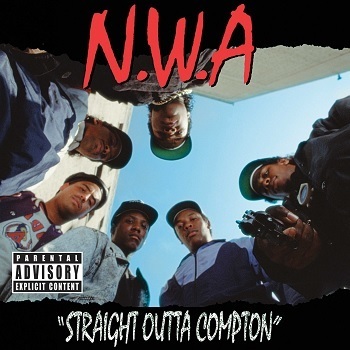
If you'd asked me at the time, I'd have said the fear and hatred wasn't of people with brown skin, but of that specific tribe they have in Chicago -- you know, the guys with the weird slang, music and clothes, the dope fiends who murder everyone they see. It was all part of the bizarro nature of the cities, as perceived from afar -- a combination of hyper-aggressive savages and frivolous white elites. Their ways are strange. And it wasn't like pop culture was trying to talk me out of it:

Ruthless Records"... And Into Some Nightmares"
It's not just perception, either -- the stats back up the fact that these are parallel universes. People living in the countryside are twice as likely to own a gun and will probably get married younger. People in the urban "blue" areas talk faster and walk faster. They are more likely to be drug abusers but less likely to be alcoholics. The blues are less likely to own land and, most importantly, they're less likely to be Evangelical Christians.
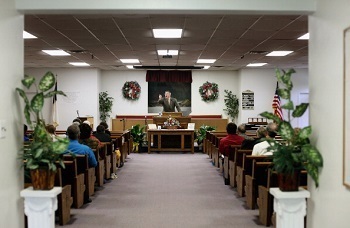
It's not just perception, either -- the stats back up the fact that these are parallel universes. People living in the countryside are twice as likely to own a gun and will probably get married younger. People in the urban "blue" areas talk faster and walk faster. They are more likely to be drug abusers but less likely to be alcoholics. The blues are less likely to own land and, most importantly, they're less likely to be Evangelical Christians.

Mario Tama/Getty ImagesA day without hellfire and brimstone is like a day without sunshine.
In the small towns, this often gets expressed as "They don't share our values!" and my progressive friends love to scoff at that. "What, like illiteracy and homophobia?!?!"
Nope. Everything.
4Trends Always Start In The Cities -- And Not All Of Them Are Good
 Brian Blanco/Getty Images
Brian Blanco/Getty Images
The cities are always living in the future. I remember when our little town got our first Chinese restaurant and, 20 years later, its first fancy coffee shop. All of this stuff had turned up in movies (set in L.A., of course) decades earlier. I remember watching '80s movies and mocking the "Valley Girl" stereotypes -- young girls from, like, California who would, like, say, "like" in between every third word. Twenty years later, you can hear me doing the same in every Cracked podcast. The cancer started in L.A. and spread to the rest of America.
Well, the perception back then was that those city folks were all turning atheist, abandoning church for their bisexual sex parties. That, we were told, was literally a sign of the Apocalypse. Not just due to the spiritual consequences (which were dire), but the devastation that would come to the culture. I couldn't imagine any rebuttal. In that place, at that time, the church was everything. Don't take my word for it -- listen to the experts:
 via Gallup
via Gallup
Church was where you made friends, met girls, networked for jobs, got social support. The poor could get food and clothes there, couples could get advice on their marriages, addicts could try to get clean. But now we're seeing a startling decline in Christianity among the general population, the godless disease having spread alongside Valley Girl talk. So according to Fox News, what's the result of those decadent, atheist, amoral snobs in the cities having turned their noses up at God?
Chaos.
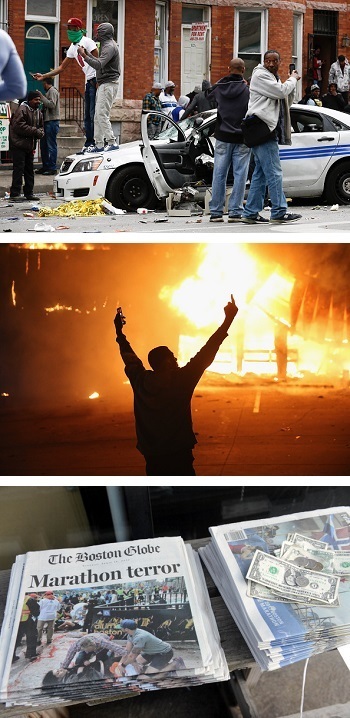
In the small towns, this often gets expressed as "They don't share our values!" and my progressive friends love to scoff at that. "What, like illiteracy and homophobia?!?!"
Nope. Everything.
4Trends Always Start In The Cities -- And Not All Of Them Are Good
 Brian Blanco/Getty Images
Brian Blanco/Getty ImagesThe cities are always living in the future. I remember when our little town got our first Chinese restaurant and, 20 years later, its first fancy coffee shop. All of this stuff had turned up in movies (set in L.A., of course) decades earlier. I remember watching '80s movies and mocking the "Valley Girl" stereotypes -- young girls from, like, California who would, like, say, "like" in between every third word. Twenty years later, you can hear me doing the same in every Cracked podcast. The cancer started in L.A. and spread to the rest of America.
Well, the perception back then was that those city folks were all turning atheist, abandoning church for their bisexual sex parties. That, we were told, was literally a sign of the Apocalypse. Not just due to the spiritual consequences (which were dire), but the devastation that would come to the culture. I couldn't imagine any rebuttal. In that place, at that time, the church was everything. Don't take my word for it -- listen to the experts:
 via Gallup
via GallupChurch was where you made friends, met girls, networked for jobs, got social support. The poor could get food and clothes there, couples could get advice on their marriages, addicts could try to get clean. But now we're seeing a startling decline in Christianity among the general population, the godless disease having spread alongside Valley Girl talk. So according to Fox News, what's the result of those decadent, atheist, amoral snobs in the cities having turned their noses up at God?
Chaos.

Drew Angerer/Getty Images, Scott Olson/Getty Images, Darren McCollester/Getty Images
The fabric has broken down, they say, just as predicted. And what rural Americans see on the news today is a sneak peek at their tomorrow.
The savages are coming.
Blacks riot, Muslims set bombs, gays spread AIDS, Mexican cartels behead children, atheists tear down Christmas trees. Meanwhile, those liberal Lena Dunhams in their $5,000-a-month apartments sip wine and say, "But those white Christians are the real problem!" Terror victims scream in the street next to their own severed limbs, and the response from the elites is to cry about how men should be allowed to use women's restrooms and how it's cruel to keep chickens in cages.
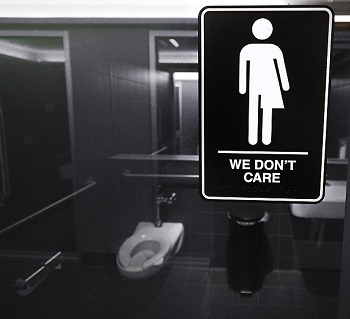
The fabric has broken down, they say, just as predicted. And what rural Americans see on the news today is a sneak peek at their tomorrow.
The savages are coming.
Blacks riot, Muslims set bombs, gays spread AIDS, Mexican cartels behead children, atheists tear down Christmas trees. Meanwhile, those liberal Lena Dunhams in their $5,000-a-month apartments sip wine and say, "But those white Christians are the real problem!" Terror victims scream in the street next to their own severed limbs, and the response from the elites is to cry about how men should be allowed to use women's restrooms and how it's cruel to keep chickens in cages.

Sara D. Davis/Getty ImagesBoth sides agree with that slogan, but with completely different intentions.
Madness. Their heads are so far up their asses that they can't tell up from down. Basic, obvious truths that have gone unquestioned for thousands of years now get laughed at and shouted down -- the fact that hard work is better than dependence on government, that children do better with both parents in the picture, that peace is better than rioting, that a strict moral code is better than blithe hedonism, that humans tend to value things they've earned more than what they get for free, that not getting exploded by a bomb is better than getting exploded by a bomb.
Or as they say out in the country, "Don't piss on my leg and tell me it's raining."
The foundation upon which America was undeniably built -- family, faith, and hard work -- had been deemed unfashionable and small-minded. Those snooty elites up in their ivory tower laughed as they kicked away that foundation, and then wrote 10,000-word thinkpieces blaming the builders for the ensuing collapse.
3The Rural Areas Have Been Beaten To Shit
 Mario Tama/Getty Images
Mario Tama/Getty Images
Don't message me saying all those things I listed are wrong. I know they're wrong. Or rather, I think they're wrong, because I now live in a blue county and work for a blue industry. I know the Good Old Days of the past were built on slavery and segregation, I know that entire categories of humanity experienced religion only as a boot on their neck. I know that those "traditional families" involved millions of women trapped in kitchens and bad marriages. I know gays lived in fear and abortions were back-alley affairs.
I know the changes were for the best.
Try telling that to anybody who lives in Trump country.
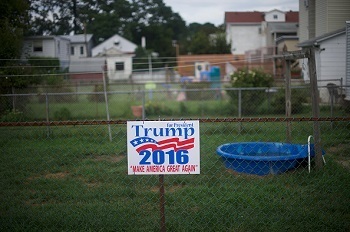
Madness. Their heads are so far up their asses that they can't tell up from down. Basic, obvious truths that have gone unquestioned for thousands of years now get laughed at and shouted down -- the fact that hard work is better than dependence on government, that children do better with both parents in the picture, that peace is better than rioting, that a strict moral code is better than blithe hedonism, that humans tend to value things they've earned more than what they get for free, that not getting exploded by a bomb is better than getting exploded by a bomb.
Or as they say out in the country, "Don't piss on my leg and tell me it's raining."
The foundation upon which America was undeniably built -- family, faith, and hard work -- had been deemed unfashionable and small-minded. Those snooty elites up in their ivory tower laughed as they kicked away that foundation, and then wrote 10,000-word thinkpieces blaming the builders for the ensuing collapse.
3The Rural Areas Have Been Beaten To Shit
 Mario Tama/Getty Images
Mario Tama/Getty ImagesDon't message me saying all those things I listed are wrong. I know they're wrong. Or rather, I think they're wrong, because I now live in a blue county and work for a blue industry. I know the Good Old Days of the past were built on slavery and segregation, I know that entire categories of humanity experienced religion only as a boot on their neck. I know that those "traditional families" involved millions of women trapped in kitchens and bad marriages. I know gays lived in fear and abortions were back-alley affairs.
I know the changes were for the best.
Try telling that to anybody who lives in Trump country.

Mark Makela/Getty ImagesHard to be thrilled about Clinton when your Trump sign is the most valuable thing you own.
They're getting the shit kicked out of them. I know, I was there. Step outside of the city, and the suicide rate among young people fucking doubles. The recession pounded rural communities, but all the recovery went to the cities. The rate of new businesses opening in rural areas has utterly collapsed.
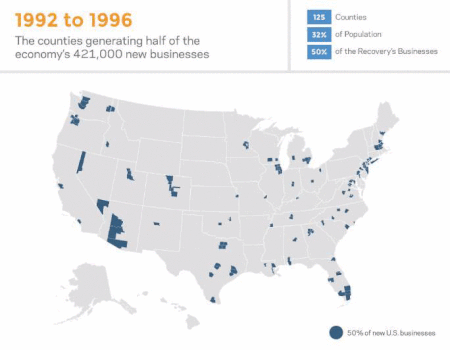
They're getting the shit kicked out of them. I know, I was there. Step outside of the city, and the suicide rate among young people fucking doubles. The recession pounded rural communities, but all the recovery went to the cities. The rate of new businesses opening in rural areas has utterly collapsed.

Economic Innovation GroupThey could all move to Vegas, but then there's that whole "decadence and apocalypse" thing.
See, rural jobs used to be based around one big local business -- a factory, a coal mine, etc. When it dies, the town dies. Where I grew up, it was an oil refinery closing that did us in. I was raised in the hollowed-out shell of what the town had once been. The roof of our high school leaked when it rained. Cities can make up for the loss of manufacturing jobs with service jobs -- small towns cannot. That model doesn't work below a certain population density.
If you don't live in one of these small towns, you can't understand the hopelessness. The vast majority of possible careers involve moving to the city, and around every city is now a hundred-foot wall called "Cost of Living." Let's say you're a smart kid making $8 an hour at Walgreen's and aspire to greater things. Fine, get ready to move yourself and your new baby into a 700-square-foot apartment for $1,200 a month, and to then pay double what you're paying now for utilities, groceries, and babysitters. Unless, of course, you're planning to move to one of "those" neighborhoods (hope you like being set on fire!).
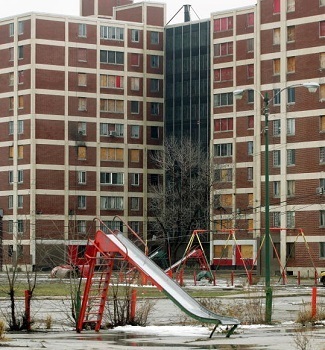
See, rural jobs used to be based around one big local business -- a factory, a coal mine, etc. When it dies, the town dies. Where I grew up, it was an oil refinery closing that did us in. I was raised in the hollowed-out shell of what the town had once been. The roof of our high school leaked when it rained. Cities can make up for the loss of manufacturing jobs with service jobs -- small towns cannot. That model doesn't work below a certain population density.
If you don't live in one of these small towns, you can't understand the hopelessness. The vast majority of possible careers involve moving to the city, and around every city is now a hundred-foot wall called "Cost of Living." Let's say you're a smart kid making $8 an hour at Walgreen's and aspire to greater things. Fine, get ready to move yourself and your new baby into a 700-square-foot apartment for $1,200 a month, and to then pay double what you're paying now for utilities, groceries, and babysitters. Unless, of course, you're planning to move to one of "those" neighborhoods (hope you like being set on fire!).

Tim Boyle/Getty ImagesThat is, if they don't replace the only room you can afford with a $3,300-per-month high-rise.
In a city, you can plausibly aspire to start a band, or become an actor, or get a medical degree. You can actually have dreams. In a small town, there may be no venues for performing arts aside from country music bars and churches. There may only be two doctors in town -- aspiring to that job means waiting for one of them to retire or die. You open the classifieds and all of the job listings will be for fast food or convenience stores. The "downtown" is just the corpses of mom and pop stores left shattered in Walmart's blast crater, the "suburbs" are trailer parks. There are parts of these towns that look post-apocalyptic.
I'm telling you, the hopelessness eats you alive.
And if you dare complain, some liberal elite will pull out their iPad and type up a rant about your racist white privilege. Already, someone has replied to this with a comment saying, "You should try living in a ghetto as a minority!" Exactly. To them, it seems like the plight of poor minorities is only used as a club to bat away white cries for help. Meanwhile, the rate of rural white suicides and overdoses skyrockets. Shit, at least politicians act like they care about the inner cities.
↓Continue Reading Below
2Everyone Lashes Out When They Don't Have A Voice

In a city, you can plausibly aspire to start a band, or become an actor, or get a medical degree. You can actually have dreams. In a small town, there may be no venues for performing arts aside from country music bars and churches. There may only be two doctors in town -- aspiring to that job means waiting for one of them to retire or die. You open the classifieds and all of the job listings will be for fast food or convenience stores. The "downtown" is just the corpses of mom and pop stores left shattered in Walmart's blast crater, the "suburbs" are trailer parks. There are parts of these towns that look post-apocalyptic.
I'm telling you, the hopelessness eats you alive.
And if you dare complain, some liberal elite will pull out their iPad and type up a rant about your racist white privilege. Already, someone has replied to this with a comment saying, "You should try living in a ghetto as a minority!" Exactly. To them, it seems like the plight of poor minorities is only used as a club to bat away white cries for help. Meanwhile, the rate of rural white suicides and overdoses skyrockets. Shit, at least politicians act like they care about the inner cities.
↓Continue Reading Below
2Everyone Lashes Out When They Don't Have A Voice

Elijah Nouvelage/Getty Images
It really does feel like the worst of both worlds: all the ravages of poverty, but none of the sympathy. "Blacks burn police cars, and those liberal elites say it's not their fault because they're poor. My son gets jailed and fired over a baggie of meth, and those same elites make jokes about his missing teeth!" You're everyone's punching bag, one of society's last remaining safe comedy targets.

It really does feel like the worst of both worlds: all the ravages of poverty, but none of the sympathy. "Blacks burn police cars, and those liberal elites say it's not their fault because they're poor. My son gets jailed and fired over a baggie of meth, and those same elites make jokes about his missing teeth!" You're everyone's punching bag, one of society's last remaining safe comedy targets.

Larry W. Smith/Getty ImagesJust because you can afford the big bottle of Pepsi doesn't mean people are punching up when roasting you.
They take it hard. These are people who come from a long line of folks who took pride in looking after themselves. Where I'm from, you weren't a real man unless you could repair a car, patch a roof, hunt your own meat, and defend your home from an intruder. It was a source of shame to be dependent on anyone -- especially the government. You mowed your own lawn and fixed your own pipes when they leaked, you hauled your own firewood in your own pickup truck. (Mine was a 1994 Ford Ranger! The current owner says it still runs!)
Not like those hipsters in their tiny apartments, or "those people" in their public housing projects, waiting for the landlord any time something breaks, knowing if things get too bad they can just pick up and move. When you don't own anything, it's all somebody else's problem. "They probably don't pay taxes, either! Just treating America itself as a subsidized apartment they can trash!"

They take it hard. These are people who come from a long line of folks who took pride in looking after themselves. Where I'm from, you weren't a real man unless you could repair a car, patch a roof, hunt your own meat, and defend your home from an intruder. It was a source of shame to be dependent on anyone -- especially the government. You mowed your own lawn and fixed your own pipes when they leaked, you hauled your own firewood in your own pickup truck. (Mine was a 1994 Ford Ranger! The current owner says it still runs!)
Not like those hipsters in their tiny apartments, or "those people" in their public housing projects, waiting for the landlord any time something breaks, knowing if things get too bad they can just pick up and move. When you don't own anything, it's all somebody else's problem. "They probably don't pay taxes, either! Just treating America itself as a subsidized apartment they can trash!"

Charley Gallay/Getty Images"Oh dear me, the water pressure appears to be off. Time to burn it all down and then sue for a bigger house."
The rural folk with the Trump signs in their yards say their way of life is dying, and you smirk and say what they really mean is that blacks and gays are finally getting equal rights and they hate it. But I'm telling you, they say their way of life is dying because their way of life is dying. It's not their imagination. No movie about the future portrays it as being full of traditional families, hunters, and coal mines. Well, except for Hunger Games, and that was depicted as an apocalypse.
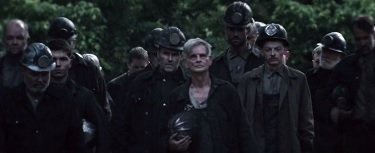
The rural folk with the Trump signs in their yards say their way of life is dying, and you smirk and say what they really mean is that blacks and gays are finally getting equal rights and they hate it. But I'm telling you, they say their way of life is dying because their way of life is dying. It's not their imagination. No movie about the future portrays it as being full of traditional families, hunters, and coal mines. Well, except for Hunger Games, and that was depicted as an apocalypse.

Lionsgate FilmsInternet startup companies weren't suffering under President Snow for a very good reason.
So yes, they vote for the guy promising to put things back the way they were, the guy who'd be a wake-up call to the blue islands. They voted for the brick through the window.
It was a vote of desperation.
1Assholes Are Heroes
 Spencer Platt/Getty Images
Spencer Platt/Getty Images
"But Trump is objectively a piece of shit!" you say. "He insults people, he objectifies women, and cheats whenever possible! And he's not an everyman; he's a smarmy, arrogant billionaire!"
Wait, are you talking about Donald Trump, or this guy:

So yes, they vote for the guy promising to put things back the way they were, the guy who'd be a wake-up call to the blue islands. They voted for the brick through the window.
It was a vote of desperation.
1Assholes Are Heroes
 Spencer Platt/Getty Images
Spencer Platt/Getty Images"But Trump is objectively a piece of shit!" you say. "He insults people, he objectifies women, and cheats whenever possible! And he's not an everyman; he's a smarmy, arrogant billionaire!"
Wait, are you talking about Donald Trump, or this guy:

Marvel StudiosMake The Avengers Assemble Again.
You've never rooted for somebody like that? Someone powerful who gives your enemies the insults they deserve? Somebody with big fun appetites who screws up just enough to make them relatable? Like Dr. House or Walter White? Or any of the several million renegade cop characters who can break all the rules because they get shit done? Who only get shit done because they don't care about the rules?
"But those are fictional characters!" Okay, what about all those millionaire left-leaning talk show hosts? You think they keep their insults classy? Tune into any bit about Chris Christie and start counting down the seconds until the fat joke. Google David Letterman's sex scandals. But it's okay, because they're on our side, and everybody wants an asshole on their team -- a spiked bat to smash their enemies with. That's all Trump is. The howls of elite outrage are like the sounds of bombs landing on the enemy's fortress. The louder the better.
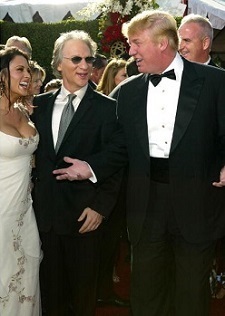
You've never rooted for somebody like that? Someone powerful who gives your enemies the insults they deserve? Somebody with big fun appetites who screws up just enough to make them relatable? Like Dr. House or Walter White? Or any of the several million renegade cop characters who can break all the rules because they get shit done? Who only get shit done because they don't care about the rules?
"But those are fictional characters!" Okay, what about all those millionaire left-leaning talk show hosts? You think they keep their insults classy? Tune into any bit about Chris Christie and start counting down the seconds until the fat joke. Google David Letterman's sex scandals. But it's okay, because they're on our side, and everybody wants an asshole on their team -- a spiked bat to smash their enemies with. That's all Trump is. The howls of elite outrage are like the sounds of bombs landing on the enemy's fortress. The louder the better.

Kevin Winter/Getty ImagesAnd when cameras record said elites BFFing with their supposed enemy, even better.
Already some of you have gotten angry, feeling this gut-level revulsion at any attempt to excuse or even understand these people. After all, they're hardly people, right? Aren't they just a mass of ignorant, rageful, crude, cursing, spitting subhumans?
Gee, I hope not. I have to hug a bunch of them at Thanksgiving. And when I do, it will be with the knowledge that if I hadn't moved away, I'd be on the other side of the fence, leaving nasty comments on this article the alternate universe version of me wrote.
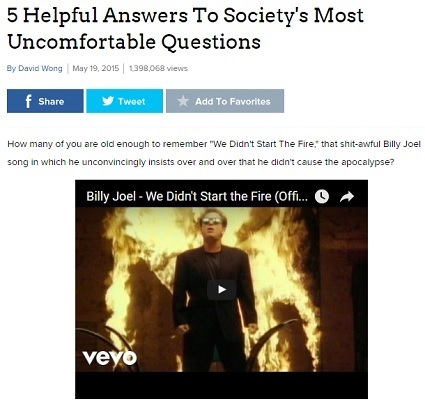
Already some of you have gotten angry, feeling this gut-level revulsion at any attempt to excuse or even understand these people. After all, they're hardly people, right? Aren't they just a mass of ignorant, rageful, crude, cursing, spitting subhumans?
Gee, I hope not. I have to hug a bunch of them at Thanksgiving. And when I do, it will be with the knowledge that if I hadn't moved away, I'd be on the other side of the fence, leaving nasty comments on this article the alternate universe version of me wrote.

CrackedAnd not just because I reminded Rural Me of Billy Joel's worst song ever.
It feels good to dismiss people, to mock them, to write them off as deplorables. But you might as well take time to try to understand them, because I'm telling you, they'll still be around long after Trump is gone.
David Wong is the Executive Editor of Cracked, his most recent novel is now in development as a TV series and just came out in paperback. Robert Evans googled like a motherfucker for this article. You should buy his book.
It feels good to dismiss people, to mock them, to write them off as deplorables. But you might as well take time to try to understand them, because I'm telling you, they'll still be around long after Trump is gone.
David Wong is the Executive Editor of Cracked, his most recent novel is now in development as a TV series and just came out in paperback. Robert Evans googled like a motherfucker for this article. You should buy his book.
Did Marinwood get off the Target List for HUD (What about Marin Supervisors?)
Dick Spotswood: Trump’s election could take Marin off HUD’s target list

POSTED: |
8 COMMENTS
Donald Trump’s upset presidential victory coupled with a Republican majority Congress will have significant Marin implications.
A major change will come with the expected shake-up of the federal Department of Housing and Urban Development. Marin has been under intense pressure from HUD, not only to develop more affordable housing, but to “affirmatively further fair housing.”
That’s HUD 2015 rule utilizing quotas by ZIP code to guarantee that sufficient affordable housing is provided in each city, town and village for “underserved” African-American and non-white Hispanic households.
HUD’s first test case was New York City’s prosperous suburb, Westchester County. That’s where HUD pursued litigation linked to a compact similar to the compliance agreement Marin’s Board of Supervisors signed under pressure with HUD in 2011. HUD’s goal was to bring the reluctant county into compliance with strict federal diversity guidelines.
Westchester is said to be New York’s Marin and Marin was widely expected to be HUD’s second test case in 2017.
Westchester was a reliably blue county until HUD pushed hard. The upshot was a voter revolt that elected a Republican county executive, Rob Astorino. The county’s elected combined mayor and chief executive, Astorino is a bantam-weight street fighter who consistently fought a rear guard action against the determined federal agency.
With Trump’s victory, the housing activist concept of “affirmatively furthering fair housing” is likely one of the new administration’s first casualties. Trump is expected to gut HUD’s headcount. That’s a strategy Republican administrations use to dispose of career bureaucrats perceived as being in their opponents’ ideological camp.
New York-area rumors are that Astorino, in other matters a moderate suburban Republican, is on Trump’s short list to be HUD secretary. Trump, who owns a golf course in Westchester, knows Astorino. The county’s top honcho supported Trump, despite the usual reservations.
With federal pressure likely trailing off in coming months, Marin’s commitment to provide a more diverse community will be tested. Many Marinites opposing HUD’s strong-arm tactics pleaded that the county was willing and able to move diversity forward on its own initiative.
Diversity is an overdue goal that can be achieved without blockbuster developments, but only if the political will is strong enough.
While local control is far superior to Uncle Sam calling the shots, the challenge now is for Marin to keep its promise absent threats of federal intervention. See Full Article HERE
Editor's Note: Marinwood has been the target for the Board of Supervisor for massive HUD affordable housing projects for decades. Susan Adams silently lobbied her fellow supervisors and the Association of Bay Area Governments to make Marinwood a "priority development area" which would mean massive subsidies for low income housing developers. She beamed with pride in her skill at political manipulation of the local community to make Marinwood Plaza a shining example. Bridge Housing was lured with massive subsidies. When her plans finally were revealed to the community, she denied any knowledge. One deception lead to another and finally led to her political defeat in 2014. The affordable housing lobby only is profitable (and hugely so) when it has access to massive government subsidies. This is very likely to change under a Trump administration. Sensible development that takes community infrastructure, traffic and need for new schools will be welcomed. Massive crony development that places great tax burden on our community will not have an easy path to development.
Tuesday, November 15, 2016
Joel Kotkin and the "Texas Way" of Urbanism and Richard Florida writer of the "Creative Class".
Highlights
Full Discussion
Published on Nov 14, 2016
Joel Kotkin and Richard Florida bring their unique perspectives on urban and suburban development to the Kansas City Area Development Council's Annual Meeting on November 4th, 2016.
They discuss issues facing most cities today, including economic expansion, transportation, cultural environments, the millennial generation, infrastructure, job growth, population, competitive regions and strategies to develop upcoming hot spots like Kansas City, Missouri.
Joel Kotkin says, "The federal government should go to Kansas City and other cities like it and say 'here's a bunch of money, you figure out how to do it.' Don't tell us how to do it because it may not fit our model."
While Richard Florida addresses the changing lifestyle trends, "I do see this preference for a new kind of lifestyle that is much more blended. And it's what urbanists have always talked about."
Watch the video above to hear a short recap of their provocative views on the future of development.
They discuss issues facing most cities today, including economic expansion, transportation, cultural environments, the millennial generation, infrastructure, job growth, population, competitive regions and strategies to develop upcoming hot spots like Kansas City, Missouri.
Joel Kotkin says, "The federal government should go to Kansas City and other cities like it and say 'here's a bunch of money, you figure out how to do it.' Don't tell us how to do it because it may not fit our model."
While Richard Florida addresses the changing lifestyle trends, "I do see this preference for a new kind of lifestyle that is much more blended. And it's what urbanists have always talked about."
Watch the video above to hear a short recap of their provocative views on the future of development.
Full Discussion
The True Meaning of Joel Kotkin's 'Localism'
Donald Trump’s surprise presidential victory last week has many hydra-headed explanations, with no shortage of pundits with perfect hindsight to proffer them. Joel Kotkin, the author and Chapman University geographer, thinks he has part of the answer: A strong distaste for the federal power exercised by President Obama activated an element of Trump supporters that many underestimated. ”If you put all your faith in an administrative executive dictatorship,” Kotkin writes in an email, “sometimes things break a different way than you expect.”
In our recent CityLab interview (and live debate with Richard Florida, recapped above), Kotkin called for a “return” to a mode of governance he calls “localism,” in which political decisions are largely made by and for community members and their direct representatives. Kotkin maintains that Obama “governed from above,” making decisions on planning, housing, environment and education that were once reserved for decentralized local governments. (This is, to be sure, an arguable point.) Such “hypercentralized” federal governance tends to adhere to the urban planning ideals promoted by “new urbanism,” with its emphasis on denser housing, mass transit, and walkable streets—all of which stand to limit Americans’ personal freedoms, he thinks.
The particulars of this philosophy are still under construction, but the vision is framed by Kotkin’s belief that suburban homeowners are more likely to feel invested and committed to their community’s success than urbanites. Kotkin sees “localism” as a bipartisan stance, noting that he also objects to move by conservative legislatures that reduce the power of more liberal cities. “Localism means experimentation and embracing diverse policy options,” he writes.
I followed up with Kotkin on our first conversation, because so much of what we discussed resonates with the themes of this post-election season—the deepening urban, suburban, and rural divides, the extent of government intrusions on Americans’ private lives, and the questions around what voters really are calling for. Two weeks ago, “localism” might have been understood a weapon for conservative rural and suburban Americans to wield against a left-leaning Federal juggernaut. Now, Kotkin hopes his philosophy might also be embraced by liberals—yes, including those in pro-density cities—to push back against a president-elect with an authoritarian bent. “I would hope now that progressives will rally to decentralization, and fight attempts by the new administration to centralize power,” he writes via email. “In a country that is so divided by ideology, lifestyle, economy and religion (or lack of), it seems that localism provides the best way to accommodate differences.”
Monday, November 14, 2016
Can We Build Cities Out Of Apartments the Size of Parking Spaces?
 |
| Some urban planners call this "efficient and humane" |
© Eugene Lubomir
See full article here:
Americans are not used to living in small spaces; a few years ago when Apartment Therapy wrote about a 430 square foot apartment in Paris that housed a family of four, commenters were outraged, considered it cruel, with one saying " In the US, the children would be taken." In the New York Times, Allison Arieff wonders How small is too small?
Arrieff looks at the range of small unit projects being proposed in New York and San Francisco that we have covered in TreeHugger (see related links at left) but also the Eugene Lobomir's wonderful upLIFT competition entry (done in collaboration with atr+d & Brian Schulman). Lubomir describes the design:
These plug and play units are completely prefabricated, injection moulded panels made from recycled materials. As interchangeable panels, variety and customization become the standard condition.

© Eugene Lubomir
The units weigh about the same as a car, and so that they can be delivered on a truck and parked in pre-existing spaces. The upLIFT "appropriates the space of the automobile.... in an effort to re-envision space of human occupation."
The units look perfectly reasonable for a single person, more than enough when the city is your living room and entertainment centre. As Allison writes,
Small housing units can be well designed, though their success is contingent on the success of the urban setting in which they exist. In other words, what’s outside the door needs to be compelling enough to make up for what might otherwise be internalized inside a larger home.The real issue is going to be the accommodation of urban families. Many people don't believe that kids belong in apartments in the city; The deputy mayor of Toronto recently questioned the merits of it, saying “I mean, I could just see now: ‘Where’s little Ginny?’ ‘Well, she’s downstairs playing in the traffic on her way to the park!’”
In fact people do it all over the world, and we are going to be seeing a lot more of it in North America. More in the New York Times
$100K Minimum Wage' For 220,000 Highly-Compensated California Public Employees Costs Taxpayers $35B
$100K Minimum Wage' For 220,000 Highly-Compensated California Public Employees Costs Taxpayers $35B
CONTRIBUTOR
I cover the “daily greed” of national, state, and local politics.
In California, according to data captured at OpenTheBooks.com, 212 city and small town managers out-earn every governor of the 50 states ($180,000).
In many states, public service has little to do with serving the public and everything to do with using the public’s money to serve politicians. Whenever we open the books, California is consistently among the worst offenders. Recently, we found ‘animal collection curators’ making $110,290; city librarians earning $222,320; public utility commission bosses at $550,028; and county hospital doctors making $1.274 million.
This spring, at Forbes, we exposed 50,000 Illinois public employees earning six-figure salaries who cost taxpayers $8 billion. In California the numbers are exponentially larger: 218,667 employees making six-figures who cost $35 billion. For example, Illinois has 72 ‘city managers’ out-earning every governor of the 50 states. But, in California, the salaries of 171 assistant city managers average $201,550!
Using our interactive mapping tool, quickly review (by ZIP code) the 220,000 California public employees who earn more than $100,000. Just click on a pin and scroll down to search the results rendered in the chart beneath the map.
Here are a few examples of what you’ll uncover by ZIP code:
· 90012, Los Angeles – the #1 ZIP code in California with 42,007 six-figure employees costing taxpayers $7.5 billion per year. The highly compensated LA ‘Port Pilot’ John Betz earned $482,792 helping cargo ships navigate the harbor and ten other ‘port pilots’ were paid an additional $3.7 million in salary plus overtime. Union contracts mandate the overtime abuses.
· 92502, Riverside County – the home of Lee Wagner, an Assistant Sheriff who netted $653,025. Wagner’s base salary was $234,584, but received a salary spike by cashing-in unused banks of benefits, i.e. leave. Also, the county highly compensated its ‘staff psychiatrists’: Charles Yates ($472,175) and David Dinicola ($433,422).
· 92522, City of Riverside – two ‘assistant city managers’ each exceed $200,000 in salary- Deanna Lorson ($220,994) and Alfred Zelinka ($209,700). While in the utilities department, eighteen ‘power line technicians’ made $105,572 and their manager cleaned off $198,516.
· 94102, San Francisco – William J. Coaker, Jr. netted $507,832 as the Chief Investment Officer (CIO) for the City of San Francisco. In contrast, the CIO at CalPERS (California Public Employees Retirement System) only made $456,877 last year – managing the largest pension fund in the United States with $301 billion in assets. And, it’s good to be a truck driver in San Francisco. Thirty highly compensated drivers made $100,000 plus with Jeffrey Lamendola earning $184,767. Two city bricklayers made $106,681 and $101,460 respectively. Who knew that cities employed six-figure bricklayers?
· 90210, Beverly Hills – 326 municipal employees earned six-figures including Art Director Aram Chobanian ($114,318) and Events and Filming Supervisor Benita Miller ($103,841). But topping the list are the fire and police staff: David Grate, Fire Battalion Chief ($349,449), Charles Ratcliff, Fire Engineer ($344,223), and Scott Dowling, Police Sergeant ($320,758).
· 94538, Fremont – Levine Harvey, the City Attorney, cost taxpayers $419,394 with a $40,000 salary raise last year. 697 highly compensated staffers cost more than $100,000 per year with thirty over $300,000. Sixteen police and fire officers earned between $321,262 to $404,810. Even the ‘animal services manager’ cost taxpayers $186,422.
Your 5 Biggest Retirement Challenges
In total, there’s roughly $35 billion in total benefit flowing to highly-compensated government workers when counting the 21,332 federal employees based in California with six figure salaries.
So, who are the biggest culprits in conferring six-figure salaries locally? We ranked the top 10 California-based units of government.
California’s largest ‘Big Dog’ governments conferring $100,000+ cash compensation.
Last year, at Forbes, we showcased the highly compensated lifeguards in Newport Beach, and determined that maybe they are the only CA public employees truly earning their pay. But this year, we found 97 first-responder lifeguards in Los Angeles County making six-figures including chiefs/captains like Adam Uehara ($256,005), Daniel Douglas ($235,091), Fernando Boiteux ($183,062) and the ‘ocean lifeguard specialists’ like Jaro Snopek ($161,713).
The stories of taxpayer abuse seem endless.
The City of Santa Monica employs twenty-six highly compensated ‘motor coach operators’ in their Big Blue Bus division each earning over $100,000 – including Vicente Gutierrez ($128,971) and Norman Colomer ($126,922). To put this in perspective, a Greyhound operator makes between $40,000 and $52,000 per year and trainees in the Santa Monica bus system make $15.37 per hour, or $30,000 per year.
Driving the large fire equipment and trucks is even more lucrative. At the City of Los Angeles, forty-three ‘apparatus operators’ employed by the City of Los Angeles earned more than $200,000. The top earner was Michael Henry who made $356,846.
Overall, there are 2,032 six-figure employees within ‘utility’ districts and another 4,660 six-figure staffers within California ‘water districts.’ President of the Public Utilities Commission Charles Mills made $550,008 and his laboratory chief, Thomas Jonathan, made $400,003.
The Municipal Utility District of Sacramento that employs 985 six-figure public employees including CEO Arlen Orchard ($440,646), Chief Financial Officer James Tracy ($304,879), Chief Power Supply and Grid Operator Paul Lau ($301,507), Chief Workforce and Technology Officer Gary King ($276,123) and the Chief Generation and Grid Assets Officer Frankie McDermott ($269,574).
California community colleges, serving the strivers – students eating ramen noodles and working two jobs – are absolutely crushing the public pay system: 13,086 community college employees earn more than $100,000, including 178 who made more than $200,000. One of those highly compensated administrators, Thomas Fallo, retired last year aftercommunity outrage regarding his $346,895 comp plan.
California, like many states, is in trouble when it comes to its pension system.
California has over 2.7 million public employees either active (2.1 million) or retired (600,000 receiving a pension check). Yet, there are only 18 million jobs. Therefore, roughly one of every six ‘paychecks’ goes to a government employee or retiree.
All Americans must think twice now before heeding the historic advice of Horace Greeley, “Go West Young Man.” The sheer size of California’s public pay system may one day collapse under its own weight.
Adam Andrzejewski is CEO of OpenTheBooks.com. See the compensation for all 2 million California public employees on your mobile device by downloading our app, Open The Books – free for Apple and Android, click here.
Editor's Note: Even in Marinwood CSD, all of our top managers and many firefighters and top staff earn above $100k. Our pension obligation is completely unsustainable in its current form. The Marinwood CSD board has actually EXPANDED the payroll and full time employees. A hard rain is gonna fall.
Subscribe to:
Comments (Atom)

